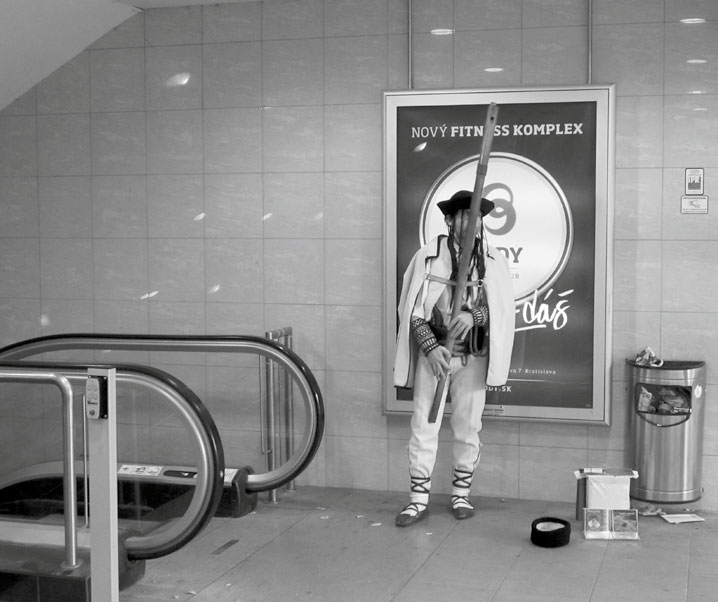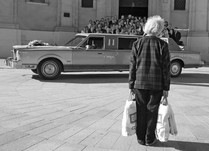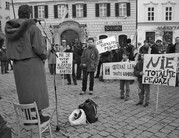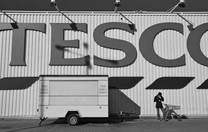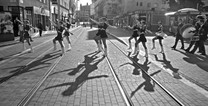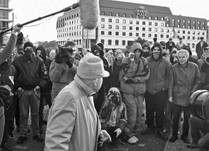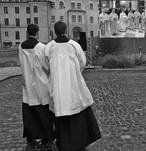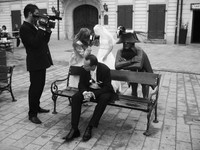The political transformations of the late 1980s initiated changes on the maps. In some cases these only entered mental maps, while in others they also altered the geopolitical maps. To some extent, this concerns all post-communist countries; Slovakia is among those on which the transformations left
their strongest marks.
The Velvet Revolution in the autumn of 1989 brought Slovakia its political and civic freedoms, but it also opened up old wounds. The Prague Spring of 1968 heralded hope for a new society, promising socialism with a human face – in other words, something between the West European variety of capitalism and the post-Stalinist reality. Western intellectuals also observed these developments with interest. Yet 21 years later, nobody was still dreaming of a new utopia, not any more. Society, tired of real socialism, had ceased to pursue any ideals, least of all those of the Velvet Revolution; all we wanted was to have the same things that our “western” neighbours had, while the handful of those who criticised the consumer society and the power of political parties and of money were soon silenced by the builders of the new capitalism. All of Czechoslovak society shared the sense of being at a dead end; in Slovakia this was further compounded by the fact that all key decisions were naturally made not in Bratislava, but in Prague. This aggravated one of the old wounds: in the conditions of dictatorship under one centralised communist party, the principles of federal rule in Czechoslovakia were impossible to realise.
The search for (also) the Slovak identity led, two years later, to the dissolution of Czechoslovakia, which, however, did not solve all the problems. Slovak nationalism defined itself in particular relative to the only politically significant, organised minority – that is, the Hungarian minority that had remained in Slovakian territory after all the wartime and post-war forced migrations. A certain permanent sense of threat came to the surface now and again, fuelled by nationalist politicians in Slovakia and in Hungary, and old fears were expressed, related to the possible revision of the Peace Treaty of Trianon (1920), which regulated the state borders in the region. It turned out that the memory of the shifting frontiers during World War II was still very much alive – as was the memory of the Slovak Republic losing a sizeable chunk of its territory to Hungary. People fought (even in the streets), above all for a language legislation that would legitimise the use of minority languages in official circulation. We should also note the voices calling for autonomy (cultural or otherwise), demanding Hungarian citizenship for Hungarians living in Slovakia, and voting rights for people of Hungarian ethnicity living outside Hungary. All this was sometimes perceived, in extreme instances, as preparation of a sort for changes to the state borders with Hungary. On the other hand, identity based on national frontiers turned out to be insufficiently strong – although after the war Czechoslovakia had lost large parts of Carpathian Ruthenia to the USSR, there were no significant voices demanding the return of those territories either then or later. Those lands had been as Slovak as some other regions of southern Slovakia, inhabited almost exclusively by a Hungarianspeaking population.
In spite of their particular over-sensitivity on the subject of language legislation, the Slovaks’ linguistic identity does not seem overly strong either. Slovakia experienced three waves of postwar emigration: the first as early as 1945, when representatives of the popular regime fled the country, fearing persecution; the second after 1948, when they were escaping the encroaching communist regime; and finally the third, after 1968, when after several months of political liberation (and the partial opening of the borders) people were fleeing “normalisation”, which had just begun. Official Czechoslovakian state policy characteristically assumed a hostile stance towards those who participated in all these waves of emigration. Illegal migration from the country was considered a crime, and was punished, among other things, with confiscation of property. Any contact with emigrants was stigmatised. To make matters worse, most Slovak emigrants in the second or third generation lose their native language, and with it the bonds with their country of origin. After 1989, the official policy changed, of course, and yet the old blight of negative attitudes towards emigrants survived in society, in a dormant state. As a consequence, the country has lost and continues to lose valuable social capital. Immigration is no better: for a long time now, Slovakia has been one of the lowest ranked countries in terms of political asylum granted.
In principle, a negative, nationalistic self-definition has become ingrained in the Slovak political reality over the last two decades, and this has played a part in the shaping of the national identity. This is compounded by an idiosyncratic account of history, which is presented either as a millennium of Hungarian oppression (forced Magyarisation in the last years of the monarchy notwithstanding), or as the Slovaks’ thousandyear- long struggle for their own state. Generally speaking, the Slovaks remain in the chapter of development, which for other national states closed with the end of the 19th century. Recently, inventing one’s national history has come back in vogue: the theory of the so-called ‘old Slovaks’ has been revived. This term is used to describe the ancient inhabitants of what is also the present-day territory of Slovakia, some one thousand years ago (in this context, the name ‘Slovaks’ is used to replace the term ‘western Slavic people’, or simply, ‘Slavs’). Also in this period a monument was erected in the Bratislava castle compound to the 9th-century Great Moravian ruler Svatopluk. Both issues aroused much controversy, particularly among historians, heightened by the fact that the statue’s author was a prominent sculptor under the previous regime. We should add that the force behind both initiatives is currently the strongest and most popular Slovakian political party, which feeds abundantly on post-communist sentiment while consistently applying a well-known paradigm: from communist internationalists to capitalist nationalists. The non-nationalist swathe of society remain defensive yet vigilant, as witnessed by the results of the general elections, and by publications, such as a recent one on “Our Slovak Myths” (Mýty naše slovenské, ed. Eduard Krekovič, Elena Mannová, Eva Krekovičová, AEPress, 2005), which features a number of excellent “demythologising” texts, and which gained unprecedented recognition throughout the country.
Concurrently, another “monumental” dispute continues in contemporary Bratislava, in relation to attempts at partial renovation work on the statue of Maria Theresa, damaged in 1920. A fairly numerous group of artists opposed the initiative – as they did not condone the erection of a replica; but the issue of its location met with an even bigger and more widespread protest – as it required the removal to another location of a 19th-century monument to a Slovak autonomist. Then again, the initiative was backed by a financial lobby, one of the most powerful at present, which probably attempted to improve its otherwise controversial image by using this historical ornament in Carrera marble. Nevertheless, claiming the heritage of Austro-Hungarian ancestors is out of the question: the notion of Slovaks as “successors of shepherds,” coined by Vladimír Mináč, remains too strong as yet. The theory, which claimed that Slovaks never, not once in their existence, possessed an elite, fitted perfectly into the Marxist, class-based vision of history.
Political identity, by contrast, is among the strongest facets of the Slovak self-image. It defines itself mainly through attitudes towards important 20th-century events, such as the First Slovak Republic, the Slovak national uprising, the communist regime of 1948–1989, and, relatively less significant, the dissolution of Czechoslovakia. This identity shows great durability; it is passed from generation to generation within families, and is very slow to change. For instance, research conducted by sociologist Vladimír Krivy demonstrated numerous correlations between the preferences of Hlinka’s people’s party electorate (1925−1945) and the followers of Mečiar’s movement for a democratic Slovakia (1991− ).
In communist Slovakia, collectivisation of farming was effected nationwide; as a rule, the only farms that were spared were the most remote, run-down, and least productive. Persecution of the Church and its followers also reached inconceivable proportions, and was felt particularly acutely in Christian Slovakia, where approximately 70% of inhabitants count themselves among the followers of the Roman Catholic Church. By 1989 the private sector, including small businesses, had been decimated, so the freshly regained liberties opened the field to brand new professions (such as small industrialist or entrepreneur). The changes also brought the revival of religious activity. Among the most prominent and rich businesspeople there are still representatives of the past anti-capitalist regime and their relations. I personally know more than one person who made their career in the past by lecturing to youth gatherings on the rotten, exploitative capitalist society, while directly after the revolution they turned into notorious new-fangled capitalists, ruthlessly fleecing their employees. Although the Church as such never gained a direct influence upon politics, most politicians tried to maintain amicable relations in those quarters, while the adjective “Christian” became almost indispensable in the name of any political party, and avowed atheists of the past regime turned into obedient children of the Church. One thing changed for sure: religious identity. At one time, Slovakia was subdivided in terms of religious confession into Catholics and Lutherans (and to some extent also Jews), whereas today this model, present until the mid-20th century and essential in terms of identity, is a thing of the past. Finally, a handful of enthusiasts, particularly Russophiles, favour the pan-Slavic identity, whose popularity peaked in the 19th century and today has negligible impact. This group, which believes in the concept of “mutually beneficial” collaboration with Russia, comes out into the open every time the Slavic world is discussed: wars in the Balkans, or recognising Kosovo’s independence.
In the 1990s, Slovakia found itself in isolation from the international community, having been gradually excluded from (western) integration processes (such as NATO and EU membership). The American Secretary of State Madeleine Albright once called Slovakia “a black hole in the heart of Europe”, and only the general elections of 1998 turned the situation around. It was then that the team of the state’s founders – the composition of which was one of the main reasons for the initial reluctance, or, in the best case, the less than enthusiastic attitude towards the young country on the part of most political and cultural elites – stepped down from the political stage. The lost years were made up, the country became integrated with western institutions, the Slovaks converted into ardent Europhiles, and they implemented the common European currency as the second post-communist state to do so, after Slovenia. They are living proof of the theory which states that countries whose citizens trust their political representation the least are also are the most eager to support European integration. A reason for potential frustration, however, lies in the fact that we achieved “fulfilled” membership of prestigious international institutions at the time when these same institutions were reaching their crisis threshold (the European Community, the European currency, and also, to an extent, NATO).
Initial forecasts after the new independent state was proclaimed predicted rapid bankruptcy. Economic success not only increased the Slovaks’ national awareness, but also brought about stronger identification with their own state. Economic depression, however, may change this Slovak-Europhile identity. In the autumn of 2011, the Slovakian government fell apart precisely during the vote on the EFSF (European Financial Stability Facility), deciding how to help EU members in debt. This was linked to a vote of confidence for the government. Recent public opinion polls indicate a rise in the following of the populist anti-European option, which is a relatively new phenomenon.
In this context, it is interesting to compare the Slovak situation with that observed in the Czech Republic. After Czechoslovakia was formed in 1918, one of the fundamental internal tensions sprang from the contrast between the then liberal, secularised, industrialised and modernist Bohemia on the one hand, and the rural, conservative, Christian Slovakia on the other. This tension marked the whole period of the first Czech Republic – a period which for Slovakia meant a great leap in development, as the Nové Slovensko exhibition, currently on at the Slovak National Gallery, so capably presents. In the third millennium the situation seems to have been reversed. The Czech Republic is becoming one of the most conservative, if still secular, countries of Europe. Reserve towards Brussels and its (and other international) institutions, towards the common currency, and towards a transnational agenda (from global warming through to the smoking ban and gender equality) not only became a flagship programme of the popular head of State, but also enjoys a widespread following and support. Not so in Slovakia: during Dzurinda’s first two terms in office, a great number of reforms were implemented, at a pace which probably went a little beyond the mental capacities of the citizens, but which made Slovakia one of the most progressive countries in Central Europe – a state whose western neighbour really strained to catch up with the reforms. The younger brother has grown up, and the elder often turns to him, if only for inspiration. The road that used to lead via Prague – which for many years had been the only road to the world at large – now became but one of many.
The Slovak contribution to contemporary culture is meagre. There is not a single Slovak Nobel laureate, the presence of Slovak stars in the realms of art, sports, or entertainment is negligible, and not one Slovak university has made it onto the TOP 500 list. Hence the inferiority sentiment (and complex) pervading the still unknown and unrecognised Slovakia – a country which is difficult to find on the world map. Paradoxically, the greatest value Slovakia has achieved is the fact of its existence, the fact that it persevered through all the attempts at its assimilation, and that towards the end of the 20th century it even accomplished its own, independent State. The question remains whether Slovakian identity is at all present in the thoughts of the young generation of Slovaks who left their country to go abroad, in every conceivable direction, after 1989.
Translated into English by Dorota Wąsik


